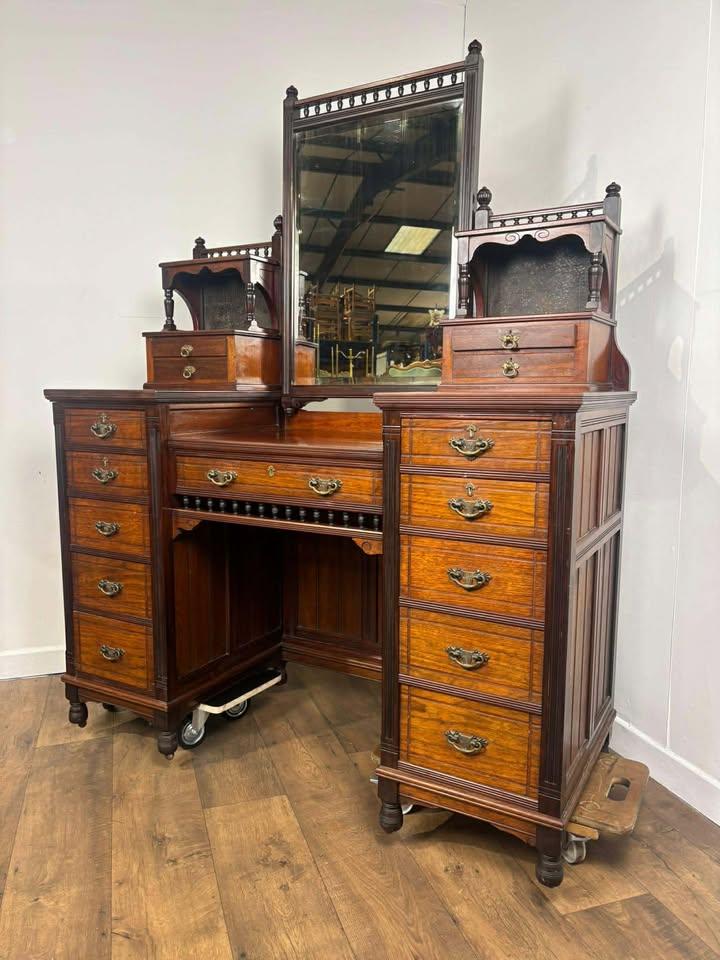At LoveAntiques we know that a table is more than just a flat surface on legs but is one of the most multi-functional items you can buy. Whether you need a table for dining, resting your coffee, working on, or just for displaying a vase, antique and vintage examples can offer the best solution around. And we have one of the largest selections anywhere on the Web. With just the curve of a leg your table can infuse your room with Gothic splendour, elegant French chic or vintage minimalist simplicity.
Because we no longer indulge in as much formal dining as before the humble antique scrub top farmhouse table is more desired than ever before. Even so special occasions calls for special tables and here a solid Oak or Mahogany table with extending leaves can’t be beat. For side tables then we have a plethora of appealing designs for you all with the added piece of mind that you are buying a quality item from a quality Dealer.
Timeless Furniture UK
Edwardian Pedestal Red Walnut Dressing
£ 450
ActFurniture LTD
Antique 20th Century Fine Quality Pair Of Oak Side Tables
£ 625
ActFurniture LTD
Antique 20th Century Good Quality Refractory Style Dining Table
£ 825
Town House Traders Ltd
Inlaid Burr Walnut Tray On Stand Coffee Table
£ 265
ActFurniture LTD
Antique 20th Century Inlaid Plant Stand In Mahogany
£ 295
ActFurniture LTD
Antique 19th Century Small Anglo Indian Side Table In Mahogany
£ 585
ActFurniture LTD
Antique 20th Century Fine Quality Plant Stand In Oak
£ 425
ActFurniture LTD
Antique 18th Century Good Quality Writing Table In Mahogany
£ 585
Founders Antiques
Antique Victorian Walnut Bobbin Chess / Games Table c.1880
£ 445
Walton House Antiques Ltd
Pair of Antique Converted Wine Tables
£ 675
Walton House Antiques Ltd
18th Century Satinwood Inlaid Oval Tray on Stand
£ 3,375
ActFurniture LTD
Antique 20th Century Jacobean Style Dining Table with 6 Chairs
£ 1,850
ActFurniture LTD
Vintage 20th Century Good Quality Coffee Table in Oak
£ 295
Paul Watson Antiques & Interiors Norfolk
Edwardian Inlaid Mahogany Kidney Shape Table
£ 500
Marylebone Antiques
Danish Vintage Rosewood Nest of Three Tables by Rosengren Hansen
£ 1,100
Danish Vintage Rosewood Nest of Three Tables by Rosengren Hansen
£ 1,100
Marylebone Antiques
ActFurniture LTD
Antique 20th Century Good Quality Coffee Table in Oak
£ 495
ActFurniture LTD
Antique 19th Century Fine Quality Writing Table in Mahogany
£ 685
Paul Watson Antiques & Interiors Norfolk
Walnut Tall Nest of Tables Circa 1930s
£ 450
Paul Watson Antiques & Interiors Norfolk
Victorian Telescopic Lamp / Plant Table
£ 450
Marylebone Antiques
Antique French Mahogany Marble Top Side Table
£ 475
Marylebone Antiques
Antique Victorian Walnut Occasional Side Table
£ 650
Marylebone Antiques
Antique Edwardian Inlaid Mahogany Side Table
£ 650
ActFurniture LTD
Antique 18th Century Demi Lune Card Table in Mahogany
£ 495
Marylebone Antiques
Yew Wood Oyster Veneer Coffee Table
£ 775
Debenham Antiques Ltd
19th Century Victorian Walnut Metamorphic Serving Table
£ 1,595
ActFurniture LTD
Antique 20th Century Small French Side Table In Mahogany
£ 295
ActFurniture LTD
Antique 19th Century Fine Quality Small Oak Side Table
£ 425
£ 825
ActFurniture LTD
Antique 20th Century Oval Breakfast Table in Mahogany
£ 625
£ 599
Knight Fine Antiques & Collectables
Antique Mahogany William IV Centre Table
£ 350
Paul Watson Antiques & Interiors Norfolk
Victorian Mah Wind-out 2 Leaf Dining Table
£ 1,350
Marylebone Antiques
Georgian Style Inlaid Mahogany Console Table
£ 1,850
Paul Watson Antiques & Interiors Norfolk
Pair C19th Mah Console Tables
£ 675
Paul Watson Antiques & Interiors Norfolk
Pair Late Regency Mahogany Console Tables
£ 850
Paul Watson Antiques & Interiors Norfolk
Fine C19th Gillows Mah Pembroke Table
£ 1,350
Paul Watson Antiques & Interiors Norfolk
C19th Mahogany Reeded Leg Drop Leaf Dining Table
£ 850
C19th Mahogany Reeded Leg Drop Leaf Dining Table
£ 850
Paul Watson Antiques & Interiors Norfolk
Marylebone Antiques
Art Deco Figured Walnut Side Table
£ 675
Marlborough Antiques & Interiors
Mid 20th Century Oak Refectory-style Table
£ 655
Walton House Antiques Ltd
Late 17th Century Side Table Simple Oak Base
£ 625
Vintage and Antique Table FAQs
How can you tell if an antique table really is antique?
Assessing the style of your antique can help you trace back not only its age, but also its origin. Europe has many decorating styles that have distinct traits, classical to architectural-style. If you identify arc cuts of a circular saw, then this suggests that the table was crafted in the 19th or 20th century. Saw marks placed at the right angle indicate that the fabricator crafted this piece in the 17th and 18th century. Coarse and irregular saw marks can be traced back to the late 16th century. Refectory dining tables, one of the known antiques, were popularized during the Victorian era to serve as a solution to demands of the modern family with a large seating capacity of up to twelve people. These are many factors that determine an antique table’s age and quality of craftsmanship. It’s important to evaluate if there are signs of refinishing made as this lowers the value. You should also look for the maker’s stamp or hallmark embedded in the base of the table. This should signify that a piece is original and not a mere reproduction.
Are antique tables valuable?
Antique tables can become an immediate focal point, by simply turning it into a lovely centerpiece of your home. From displaying your cherished photographs and collections, to setting up with beautiful dinnerware, Love Antiques has a vast selection of vintage tables online from with a multitude of design and finishes such as french carved oak, mahogany, walnut and more. As such, the antique tables popularity has risen exponentially throughout the years, and finding the right is more important than ever. The older the antique dining table, the higher the value it has. Collectors and hobbyists from the United Kingdom and all around the world have scoured every antique shop, showroom, and thrift store to find an extraordinary, one-of-a-kind piece of antique dining tables or antique furniture that can be an ultimate addition to any room.
How do I sell my antique vintage table?
Are you looking to sell vintage dining tables? Love Antiques offers an easily accessible way to advertise your antiques by simply signing up on the form. Get a chance to be seen by thousands of potential buyers everyday and have the payment completely directed to you. From oak dining tables, chairs, dressers, Love Antiques is the right portal for hobbyists, collectors, and interior designers.
At what age does a table become a vintage table?
Technically, a vintage piece is a collectible object that comes with a special value because of its considerable age, rarity, and fine artistry. An item is classified as a vintage if it’s at least 50 years old. If the item is at least 100 years old, it falls under the category of antique. Love Antiques has a full assortment of both Victorian, Georgian, and Edwardian vintage and antique furniture. We offer the most extraordinary tables antique and vintage dining tables to our discerning customers from all over the world. To know more about our antiques tables, please browse around our website to explore the myriad of options available.
How do I buy an antique table at Love Antiques?
Love Antiques is a premier resource for the most unique and intricate collectables, some of which are impossible to find throughout the United Kingdom. Our vintage tables for sale are perfect to complement the industrial look in your home. Buying vintage tables can be overwhelming with the myriad of options we have on offer. Lucky for you, Love Antiques makes the entire process seemingly effortless with just a few clicks away. To know more about our comprehensive selection, call us today and one of our specialists will be glad to assist you.


